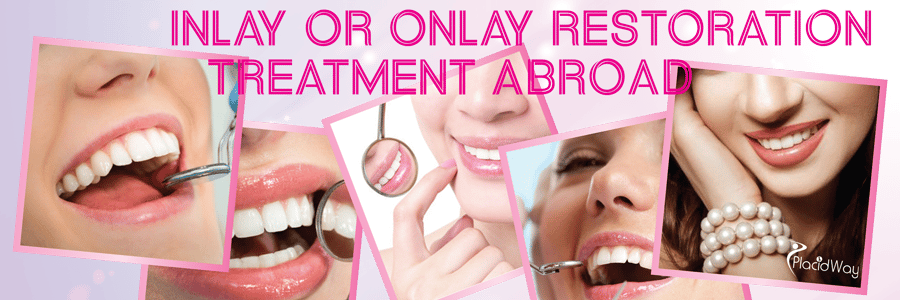
Overview
An inlay or onlay tooth restoration is a type of cosmetic dentistry that restores the substance and structure of a tooth. Onlays may also be known as crowns, which cover the surface of a damaged or decayed tooth. An inlay is a type of filling such as porcelain that is fit into a hole or cavity in a tooth and then bonded or cemented into place in order to restore function and appearance of the tooth.
Inlays
In cases where the tooth has been chipped or damaged by a cavity, an inlay is designed to restore the function, strength and integrity of the tooth. Inlays are often made of gold or porcelain. Gold is a superior structure that protects against decay and provides optimal strength and function to cavities or holes in damaged teeth.
Onlays
Deeper damage such as that caused by a fracture or decay has rotted a portion of the tooth, an onlay provides an ideal solution. Onlays provide restoration to the crown or cusp of a tooth. The onlay provides a protective cap or crown for a damaged tooth, allowing for preservation of the tooth structure that also prevents further damage.
Dental Restoration Materials
Dentists around the world use a variety of alloys or fillings in dental inlay and onlay restorations. The most common is amalgam, an alloy created through the combination of two or more metals, most commonly silver and mercury, or powdered silver and tin. The substance slowly hardens, replacing or filling missing tooth structure.
Inlay restoration most commonly utilizes tooth-colored porcelain or gold. First, an impression of the cavity or hole is made using an elastic impression material. The impression is sent to a dental laboratory where a dental technician makes the inlay.
Onlay restoration is a type of inlay that is also made by a dental technician following impressions taken by the dentist. The onlay fills a cavity or hole, and offers superior protection to the outside surface of the tooth. Like inlays, onlays are generally designed using tooth colored porcelain or gold.
The inlay and onlay are performed much like a cavity filling, with very little, if any, discomfort felt by the dental patient. Depending on amount of damage to the tooth being restored, the dentist may offer topical numbing agents, or an injection of Novocain to fully numb the area prior to work being performed. The entire procedure usually takes about an hour to an hour and a half, and is completed in two dental visits; the first visit used to assess the situation and make an impression, the second for the actual fitting.

Who Benefits from Inlay or Onlay Restoration?
Anyone suffering from damaged, fractured, or otherwise compromised tooth structure and function may benefit from inlay or onlay restoration. Restoring strength of the tooth also restores function and chewing ability. Protection against bacteria, infection, and tooth loss are also major benefits of such restoration. Individuals who have cavities that extend beyond the crown or cusp of the tooth are ideal candidates for onlay restoration.
What Does Inlay or Onlay Restoration Cost?
In the United States, the cost for an onlay or inlay will depend not only on the extent of damage, but on size required as well as location of teeth that require inlay or onlay restoration, in addition to dental laboratory costs that may vary by geographical location. In most cases, costs for an onlay or inlay range between $650 and $1,200. Average costs are roughly $900.
International dental travelers may save hundreds of dollars on inlay or onlay restoration. Visitors to Mexico may save up to 50% on restoration costs charged in the United States, while visitors to destinations such as Croatia or Turkey may save up to 75%, and those traveling to Asia save between 30 and 65%, while still retaining the quality and expertise necessary for optimal benefits and results.
Who Performs Inlay or Onlay Restoration?
When looking for a dentist, it is important to make sure they are certified. Certification is offered through standards of the American Dental Association or other accredited dental association sub-specialty certification. Other countries typically require membership or certification through Dental Colleges. For example, in India, a dentist should be certified through the Dental Council of India. In Singapore, a dentist should be registered with the College of Dental Surgeons. In Australia, dentists should be registered with the Royal Australian College of Dental Surgeons. Take the time to ask or find out about certification requirements any country you're interested in.
Get in touch with us and find out more about your options!
Dental Tourism | Cosmetic Dentistry | Implants | Root Canals | Dentures | Bridges | Orthodontics | Dental Holidays Abroad